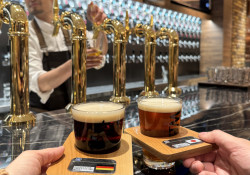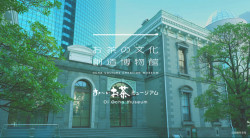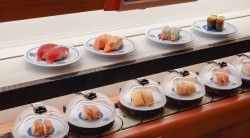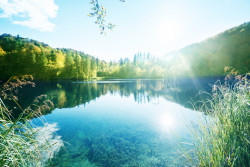
January 15, 2009
Aquavit
Chef Marcus Samuelsson introduces Scandinavian haute cuisine to Tokyo
By Metropolis
Originally published on metropolis.co.jp on January 2009

Photos courtesy of WDI
Prior to the emergence of celebrity chef Marcus Samuelsson, most people thought that Scandinavian food was all about smoked salmon, smorgasbord and deer meat. Since taking the helm at New York’s Aquavit restaurant a decade ago, however, Samuelsson has introduced savvy diners to the pleasures of… smoked salmon, smorgasbord and deer meat.
The Ethiopia-born, Sweden-raised chef didn’t reinvent northern European cooking; instead, he reinterpreted classic dishes with dramatic presentation and offbeat saucing and spicing. Samuelsson’s take on gravlax, for example, features diced potatoes perched between rectangular strips of salmon, garnished with sprigs of dill and drizzled with espresso-mustard sauce.
With the opening of Tokyo’s Aquavit in Gaienmae late last year, the cuisine—and the spirit—of the New York original have arrived intact. A chic lounge area filled with fancy Jacobsen “egg” chairs sits off to one side of the commodious entryway. Lining the shelves are glass flagons filled with fruited varieties of the restaurant’s namesake drink—a kind of Scandinavian vodka made from potatoes. At 80 proof, aquavit is not for the faint of heart (or weak of palate). The kitchen is headed up by chef Kazuhiko Tsurumi, a veteran of another Big Apple transplant, Il Mulino in Roppongi Hills.
At dinnertime, Aquavit offers only a three-course prix fixe meal; diners choose one each from a selection of nine appetizers, main dishes and desserts (¥9,250). For lunch, two course menus (¥4,700 & ¥5,900) are joined by a small à la carte selection. Not to be missed at either meal is the herring sampler. Served with a glass of Carlsberg beer and a shot of aquavit—“necessary accessories,” as the menu puts it—this dish perfectly showcases Samuelsson’s approach. The meaty white fish is prepared four ways: one is simply pickled and the other three are slathered with pasty sauces—apple-curry, sour cream, or mustard. The Vikings never had it so good.

Photos courtesy of WDI
Aquavit’s signature entrée is the “one side sautéed” salmon, a lovely dish with a thick fish filet, roasted beets and a swirl of lemon sauce, arranged in geometrically precise rows on a bare white china plate. The highlight of a recent dinner, though, was the venison loin: hunks of blood-red meat with a sauce of tart lingonberries (think European cranberry) and a side dish of spinach with the best gnocchi we’ve ever tasted. The desserts, as arty as the restaurant’s tactfully modern interior, range from classic princess cake to rosehip soup to a dense chocolate cake with sweet-salty caramel ice cream.
Considering the rough-hewn quality of typical Scandinavian cooking, Aquavit’s upscale approach occasionally misfires; the kitchen gets too cutesy with some of the fare. The mass appeal of a dish like gravlax, for instance, is in the very robustness that the restaurant’s mannered version seems determined to eliminate.
Judging by the crowd on a recent Friday evening visit, Aquavit is Tokyo’s restaurant of the moment, drawing a sophisticated crowd of couples and small groups of friends. Service is typically prompt, and the advice from maitre d’/sommelier Matteo spot-on. Despite the gloomy economic climate, chef Marcus Samuelsson’s stock is certainly on the rise in Japan.
Ned says…
Aquavit boasts an impressive Burgundy list whose greatest appeal is the judicious selection of whites, including Henri Boillot’s ’02 Meursault at ¥17,000. However, despite modest breadth by Japanese standards, there are few scintillating wines for those whose finances transcend the current clime, nor real intriguants that appeal to those like myself working with wine, or those seeking something new, exciting and not overtly expensive. In essence, the list looks quite good for all but those lacking immunity to the carnage of spelling mistakes, and for those who want to drink anything save Burgundy, ho-hum Bordeaux and California.
Standouts include rare and exorbitantly priced Californian behemoths such as Napa’s ’02 Harlan at a sweet ¥128,000. Japan is the only market in the world aside from the US where super premium Californian wine actually sells. Got to sell the stuff somewhere, I suppose.
Wines that bring a smile due to both price and quality include the pungently aromatic yet linear 2006 Navarro Gewürztraminer from Mendocino at ¥9,600, the oily yet focused ’04 FX Pichler Smaragd Gruner Veltliner from Austria’s Wachau at a very reasonable ¥9,800, and the juicy and highly gluggable ’06 Moulin a Vent from Domaine Vissoux at an acceptable ¥8,800. Yet my smile is not quite big enough to bring me to a table.
Ned Goodwin is Metropolis’ wine correspondent







